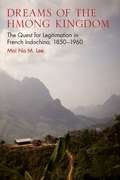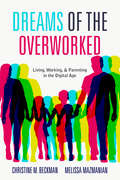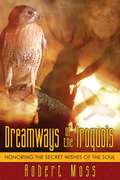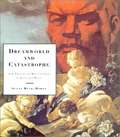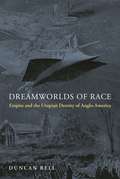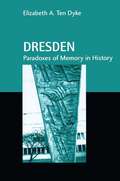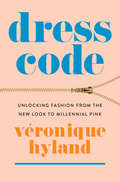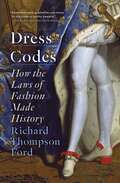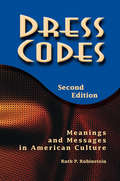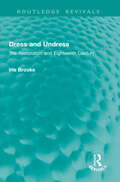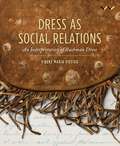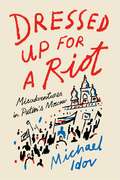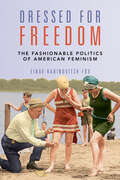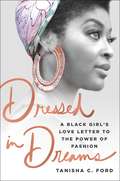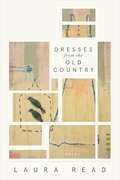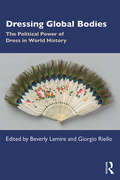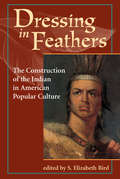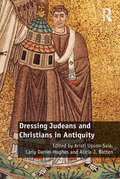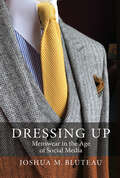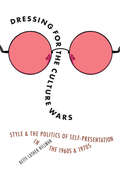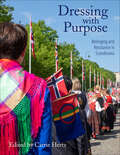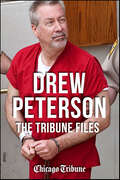- Table View
- List View
Dreams of the Hmong Kingdom
by Mai Na M. LeeCountering notions that Hmong history begins and ends with the Secret War in Laos of the 1960s and 1970s, "Dreams of the Hmong Kingdom" reveals how the Hmong experience of modernity is grounded in their sense of their own ancient past, when this now-stateless people had their own king and kingdom, and illuminates their political choices over the course of a century in a highly contested region of Asia. In China, Vietnam, and Laos, the Hmong continuously negotiated with these states and with the French to maintain political autonomy in a world of shifting boundaries, emerging nation-states, and contentious nationalist movements and ideologies. Often divided by clan rivalries, the Hmong placed their hope in finding a leader who could unify them and recover their sovereignty. In a compelling analysis of Hmong society and leadership throughout the French colonial period, Mai Na M. Lee identifies two kinds of leaders political brokers who allied strategically with Southeast Asian governments and with the French, and messianic resistance leaders who claimed the Mandate of Heaven. The continuous rise and fall of such leaders led to cycles of collaboration and rebellion. After World War II, the powerful Hmong Ly clan and their allies sided with the French and the new monarchy in Laos, but the rival Hmong Lo clan and their supporters allied with Communist coalitions. Lee argues that the leadership struggles between Hmong clans destabilized French rule and hastened its demise. Martialing an impressive array of oral interviews conducted in the United States, France, and Southeast Asia, augmented with French archival documents, she demonstrates how, at the margins of empire, minorities such as the Hmong sway the direction of history. "
Dreams of the Overworked: Living, Working, and Parenting in the Digital Age
by Christine M. Beckman Melissa MazmanianA riveting look at the real reasons Americans feel inadequate in the face of their dreams, and a call to celebrate how we support one another in the service of family and work in our daily life. Jay's days are filled with back-to-back meetings, but he always leaves work in time to pick his daughter up from swimming at 7pm, knowing he'll be back on his laptop later that night. Linda thinks wistfully of the treadmill in her garage as she finishes folding the laundry that's been in the dryer for the last week. Rebecca sits with one child in front of a packet of math homework, while three others clamor for her attention. In Dreams of the Overworked, Christine M. Beckman and Melissa Mazmanian offer vivid sketches of daily life for nine families, capturing what it means to live, work, and parent in a world of impossible expectations, now amplified unlike ever before by smart devices. We are invited into homes and offices, where we recognize the crushing pressure of unraveling plans, and the healing warmth of being together. Moreover, we witness the constant planning that goes into a "good" day, often with the aid of phones and apps. Yet, as technologies empower us to do more, they also promise limitless availability and connection. Checking email on the weekend, monitoring screen time, and counting steps are all part of the daily routine. The stories in this book challenge the seductive myth of the phone-clad individual, by showing that beneath the plastic veneer of technology is a complex, hidden system of support—our dreams being scaffolded by retired in-laws, friendly neighbors, spouses, and paid help. This book makes a compelling case for celebrating the structures that allow us to strive for our dreams, by supporting public policies and community organizations, challenging workplace norms, reimagining family, and valuing the joy of human connection.
Dreamways of the Iroquois: Honoring the Secret Wishes of the Soul
by Robert MossExplores the ancient Iroquois tradition of dreams, healing, and the recovery of the soul• Explains Native American shamanic dream practices and their applications and purpose in modern life• Shows how dreams call us to remember and honor our soul’s true purpose• Offers powerful Active Dreaming methods for regaining lost soul energy to restore our vitality and identityThe ancient teaching of the Iroquois people is that dreams are experiences of the soul in which we may travel outside the body, across time and space, and into other dimensions--or receive visitations from ancestors or spiritual guides. Dreams also reveal the wishes of the soul, calling us to move beyond our ego agendas and the web of other people’s projections into a deeper, more spirited life. They call us to remember our sacred contracts and reclaim the knowledge that belonged to us, on the levels of soul and spirit, before we entered our present life experience. In dreams we also discover where our vital soul energy may have gone missing--through pain or trauma or heartbreak--and how to get it back.Robert Moss was called to these ways when he started dreaming in a language he did not know, which proved to be an early form of the Mohawk Iroquois language. From his personal experiences, he developed a spirited approach to dreaming and living that he calls Active Dreaming.Dreamways of the Iroquois is at once a spiritual odyssey, a tribute to the deep wisdom of the First Peoples, a guide to healing our lives through dreamwork, and an invitation to soul recovery.
Dreamworld and Catastrophe: The Passing of Mass Utopia in East and West
by Susan Buck-MorssThe dream of the twentieth century was the construction of mass utopia. As the century closes, this dream is being left behind; the belief that industrial modernization can bring about the good society by overcoming material scarcity for all has been challenged by the disintegration of European socialism, capitalist restructuring, and ecological constraints. The larger social vision has given way to private dreams of material happiness and to political cynicism. Developing the notion of dreamworld as both a poetic description of a collective mental state and an analytical concept, Susan Buck-Morss attempts to come to terms with mass dreamworlds at the moment of their passing. She shows how dreamworlds became dangerous when their energy was used by the structures of power as an instrument of force against the masses. Stressing the similarities between the East and West and using the end of the Cold War as her point of departure, she examines both extremes of mass utopia, dreamworld and catastrophe. The book is in four parts. "Dreamworlds of Democracy" asks whether collective sovereignty can ever be democratic. "Dreamworlds of History" calls for a rethinking of revolution by political and artistic avant-gardes. "Dreamworlds of Mass Culture" explores the affinities between mass culture's socialist and capitalist forms. An "Afterward" places the book in the historical context of the author's collaboration with a group of Moscow philosophers and artists over the past two tumultuous decades. The book is an experiment in visual culture, using images as philosophy, presenting, literally, a way of seeing the past. Its pictorial narratives rescue historical data that with the end of the Cold War are threatened with oblivion and challenge common conceptions of what this century was all about.
Dreamworlds of Race: Empire and the Utopian Destiny of Anglo-America
by Duncan BellHow transatlantic thinkers in the late nineteenth and early twentieth centuries promoted the unification of Britain and the United StatesBetween the late nineteenth century and the First World War an ocean-spanning network of prominent individuals advocated the unification of Britain and the United States. They dreamt of the final consolidation of the Angloworld. Scholars, journalists, politicians, businessmen, and science fiction writers invested the “Anglo-Saxons” with extraordinary power. The most ambitious hailed them as a people destined to bring peace and justice to the earth. More modest visions still imagined them as likely to shape the twentieth century. Dreamworlds of Race explores this remarkable moment in the intellectual history of racial domination, political utopianism, and world order.Focusing on a quartet of extraordinary figures—Andrew Carnegie, W. T. Stead, Cecil J. Rhodes, and H. G. Wells—Duncan Bell shows how unionists on both sides of the Atlantic reimagined citizenship, empire, patriotism, race, war, and peace in their quest to secure global supremacy. Yet even as they dreamt of an Anglo-dominated world, the unionists disagreed over the meaning of race, the legitimacy of imperialism, the nature of political belonging, and the ultimate form and purpose of unification. The racial dreamworld was an object of competing claims and fantasies. Exploring speculative fiction as well as more conventional forms of political writing, Bell reads unionist arguments as expressions of the utopianism circulating through fin-de-siècle Anglo-American culture, and juxtaposes them with pan-Africanist critiques of racial domination and late twentieth-century fictional narratives of Anglo-American empire.Tracing how intellectual elites promoted an ambitious project of political and racial unification between Britain and the United States, Dreamworlds of Race analyzes ideas of empire and world order that reverberate to this day.
Dresden: Paradoxes of Memory in History (Studies in Anthropology and History)
by Elizabeth A. Ten DykeThe collapse of the German Democratic Republic prompted the East Germans to confront their personal, cultural and international past. This study of the 'Wende' - the turn of events in 1989 - is based on ethnographic and anthropological research conducted in the early 1990s. Liz Ten Dyke has developed a finely nuanced portrait of the city and its residents as they were caught up in the economic, political and social turmoil that characterized the immediate post-socialist period. By weaving together scholarly research, oral history, and "ethnographic excursions" or narratives of salient experiences, this book makes an important contribution to the study of social aspects of the past. Moving beyond paradigms presently shaping the study of memory, it details the paradoxes and contradictions inherent in remembering, making manifest the link between such contradictions and larger symbolic and political-economic contexts. In this way, the author situates the study of memory in history and shows that it is the mutability of memory, in conjuction with the uncertainty of history, that render the past a dynamic and powerful force in human society.
Dress Casual
by Deirdre ClementeAs Deirdre Clemente shows in this lively history of fashion on American college campuses, whether it's jeans and sneakers or khakis with a polo shirt, chances are college kids made it cool. The modern casual American wardrobe, Clemente argues, was born in the classrooms, dormitories, fraternity and sorority houses, and gyms of universities and colleges across the country. As young people gained increasing social and cultural clout during the early twentieth century, their tastes transformed mainstream fashion from collared and corseted to comfortable. From east coast to west and from the Ivy League to historically black colleges and universities, changing styles reflected new ways of defining the value of personal appearance, and, by extension, new possibilities for creating one's identity. The pace of change in fashion options, however, was hardly equal. Race, class, and gender shaped the adoption of casual style, and young women faced particular backlash both from older generations and from their male peers. Nevertheless, as coeds fought dress codes and stereotypes, they joined men in pushing new styles beyond the campus, into dance halls, theaters, homes, and workplaces. Thanks to these shifts, today's casual style provides a middle ground for people of all backgrounds, redefining the meaning of appearance in American culture.
Dress Code: Unlocking Fashion from the New Look to Millennial Pink
by Véronique HylandIn the spirit of works by Jia Tolentino and Anne Helen Peterson, a smart and incisive essay collection centered on the fashion industry—its history, its importance, why we wear what we wear, and why it matters—from Elle Magazine’s fashion features director.Why does fashion hold so much power over us? Most of us care about how we dress and how we present ourselves. Style offers clues about everything from class to which in-group we belong to. Bad Feminist for fashion, Dress Code takes aim at the institutions within the fashion industry while reminding us of the importance of dress and what it means for self-presentation. Everything—from societal changes to the progress (or lack thereof) of women’s rights to the hidden motivations behind what we choose to wear to align ourselves with a particular social group—can be tracked through clothing. Veronique Hyland examines thought-provoking questions such as: Why has the “French girl” persisted as our most undying archetype? What does “dressing for yourself” really mean for a woman? How should a female politician dress? Will gender-differentiated fashion go forever out of style? How has social media affected and warped our sense of self-presentation, and how are we styling ourselves expressly for it?Not everyone participates in painting, literature, or film. But there is no “opting out” of fashion. And yet, fashion is still seen as superficial and trivial, and only the finest of couture is considered as art. Hyland argues that fashion is a key that unlocks questions of power, sexuality, and class, taps into history, and sends signals to the world around us. Clothes means something—even if you’re “just” wearing jeans and a T-shirt.
Dress Codes: How the Laws of Fashion Made History
by Richard Thompson FordA &“sharp and entertaining&” (The Wall Street Journal) exploration of fashion through the ages that asks what our clothing reveals about ourselves and our society.Dress codes are as old as clothing itself. For centuries, clothing has been a wearable status symbol; fashion, a weapon in struggles for social change; and dress codes, a way to maintain political control. Merchants dressing like princes and butchers&’ wives wearing gem-encrusted crowns were public enemies in medieval societies structured by social hierarchy and defined by spectacle. In Tudor England, silk, velvet, and fur were reserved for the nobility, and ballooning pants called &“trunk hose&” could be considered a menace to good order. The Renaissance-era Florentine patriarch Cosimo de Medici captured the power of fashion and dress codes when he remarked, &“One can make a gentleman from two yards of red cloth.&” Dress codes evolved along with the social and political ideals of the day, but they always reflected struggles for power and status. In the 1700s, South Carolina&’s &“Negro Act&” made it illegal for Black people to dress &“above their condition.&” In the 1920s, the bobbed hair and form-fitting dresses worn by free-spirited flappers were banned in workplaces throughout the United States, and in the 1940s, the baggy zoot suits favored by Black and Latino men caused riots in cities from coast to coast. Even in today&’s more informal world, dress codes still determine what we wear, when we wear it—and what our clothing means. People lose their jobs for wearing braided hair, long fingernails, large earrings, beards, and tattoos or refusing to wear a suit and tie or make-up and high heels. In some cities, wearing sagging pants is a crime. And even when there are no written rules, implicit dress codes still influence opportunities and social mobility. Silicon Valley CEOs wear t-shirts and flip-flops, setting the tone for an entire industry: women wearing fashionable dresses or high heels face ridicule in the tech world, and some venture capitalists refuse to invest in any company run by someone wearing a suit. In Dress Codes, law professor and cultural critic Richard Thompson Ford presents a &“deeply informative and entertaining&” (The New York Times Book Review) history of the laws of fashion from the middle ages to the present day, a walk down history&’s red carpet to uncover and examine the canons, mores, and customs of clothing—rules that we often take for granted. After reading Dress Codes, you&’ll never think of fashion as superficial again—and getting dressed will never be the same.
Dress Codes: Meanings And Messages In American Culture
by Ruth RubinsteinRich with illustrations, this revised and updated second edition of Dress Codes systematically analyzes the meaning and relevance of clothing in American culture. Presented here is an up-to-date analysis of images of power and authority, gender, seduction (the sexy look, the alluring look, the glamorous look, the vulnerable look), wealth and beauty, youth and health, and leisure and political hierarchy. Taken together, the chapters offer to the student and the general reader a complete "semiotics of clothing" in a form that is highly readable, very entertaining, and thoroughly informative. The illustrations provide fascinating glimpses into the history of American fashion and clothing-along with their antecedents in Europe-as well as a fine collection of images from the more familiar world of contemporary America.Rubinstein has identified six distinct categories of dress in American society, upon which Dress Codes is based. "Clothing signs" were instituted by those in authority, have one meaning, indicate behavior, and are required attire (police uniforms, or the clothing of ministers and priests); ?clothing symbols," on the other hand, reflect the achievement of cultural values?wealth, beauty, you and health. The wearing of clothing symbols?designer clothing or jewelry?may have several meanings; '`'clothing tie-signs,? which are specific types of clothing that indicate membership in a community outside mainstream culture (Hasidic, Amish, or Hare Krishna attire). They were instituted by those in authority, have one meaning, they indicate expected behavior, and are required attire; ?clothing tie symbols? emanate from hopes, fears, and dreams of particular groups. They include trendy styles such as hip-hop, hippie, and gothic. Another category, ?contemporary fashion,? reflects consumer sentiments and the political and economic forces of the period. ?Personal dress,? refers to the "I" component we bring in when dressing the public self (bowtie, dramatic, or artistic attire). Many of these images have their roots in the ?collective memory? of western society. Written in a lively and entertaining style,Dress Codes will fascinate both general readers and students interested in the history of fashion and costume, fashion design, human development, and gender studies.
Dress and Undress: The Restoration and Eighteenth Century (Routledge Revivals)
by Iris BrookeOriginally published in 1958, this book deals with the details of dress – formal and informal – from the time of Charles II to the end of the eighteenth century. Most of the illustrations are taken from existing garments preserved in private collections or museums. Many verbatim descriptions are quoted from contemporary sources such as magazines, diaries, letters and newspapers. The popular idea of costume in this period is the formal aspect as shown in portraits, and the undress clothes of the time are little known although obviously commonly worn. These the author has illustrated together with the stays, hops, puffs and panniers, hairdressing and shoes that help to make up the complete appearance. The book will be of interest to those in theatre studies, costume design and social history.
Dress as Social Relations: An interpretation of Bushman dress
by Vibeke Maria ViestadThe history of dress in the South African bushTo dress is a uniquely human experience, but practices and meanings of dress vary greatly among people. In a Western cultural tradition, the practice of dressing ‘properly’ has for centuries distinguished ‘civilised’ people from ‘savages’. Through travel literature and historical ethnographic descriptions of the Bushmen of southern Africa, such perceptions and prejudices have made their mark also on the modern research tradition. Because Bushmen were widely considered to be ‘nearly naked’ the study of dress has played a limited part in academic writings on Bushman culture. In Dress as Social Relations, Vibeke Maria Viestad challenges this myth of the nearly naked Bushman and provides an interdisciplinary study of Bushman dress, as it is represented in the archives and material culture of historical Bushman communities. Maintaining a critical perspective, Viestad provides an interpretation of the significance of dress for historical Bushman people. Dress, she argues, formed an embodied practice of social relations between humans, animals and other powerful beings of the Bushman world; moreover, this complex and meaningful practice was intimately related to subsistence strategies and social identity. The historical collections under scrutiny present a wide variety of research material representing different aspects of the bodily practice of dress. Whereas the Bleek & Lloyd archive of oral myths and narratives has become renowned for its great research potential, the artefact collections of Dorothea Bleek and Louis Fourie are much less known and have not earlier been published in a richly illustrated and comprehensive way. Dress as Social Relations is aimed at scholars and students of archaeology, anthropology, material culture studies, dress studies, ethnographic studies, museology, culture historical studies and African studies, but will also be of interest to people of descendant communities.
Dressed Up for a Riot: Misadventures in Putin's Moscow
by Michael IdovA memoir of revolution, reaction, and Russian men’s fashionIn this crackling memoir, the journalist and novelist Michael Idov recounts the tempestuous years he spent living alongside—and closely observing—the media and cultural elite of Putin’s Russia. After accepting a surprise offer to become the editor in chief of GQ Russia, Idov and his family arrive in a Moscow still seething from a dubious election and the mass anti-Putin rallies that erupted in response. Idov is fascinated by the political turmoil but nonetheless finds himself pulled in unlikely directions. He becomes a tabloid celebrity, acts in a Russian movie with Snoop Dogg, befriends the members of Pussy Riot, punches an anti-Semitic magazine editor on the steps of the Bolshoi Theatre, sells an autobiographical sitcom pilot that is later changed into an anti-American farce, and writes Russia’s top-grossing domestic movie of 2015. Meanwhile, he becomes disillusioned with the splintering opposition to Putin and is briefly attracted to a kind of jaded Putinism lite—until Russia’s invasion of Ukraine thoroughly changes his mind.In Dressed Up for a Riot, Idov writes openly, sensitively, and stingingly about life in Moscow and his place in a media apparatus that sometimes undermined but more often bolstered a state system defined by cynicism, corruption, and the fanning of fake news. With humor and intelligence, he offers a close-up glimpse of what a declining world power can become.
Dressed for Freedom: The Fashionable Politics of American Feminism (Women, Gender, and Sexuality in American History)
by Einav Rabinovitch-FoxOften condemned as a form of oppression, fashion could and did allow women to express modern gender identities and promote feminist ideas. Einav Rabinovitch-Fox examines how clothes empowered women, and particularly women barred from positions of influence due to race or class. Moving from 1890s shirtwaists through the miniskirts and unisex styles of the 1970s, Rabinovitch-Fox shows how the rise of mass media culture made fashion a vehicle for women to assert claims over their bodies, femininity, and social roles. She also highlights how trends in women’s sartorial practices expressed ideas of independence and equality. As women employed new clothing styles, they expanded feminist activism beyond formal organizations and movements and reclaimed fashion as a realm of pleasure, power, and feminist consciousness. A fascinating account of clothing as an everyday feminist practice, Dressed for Freedom brings fashion into discussions of American feminism during the long twentieth century.
Dressed in Dreams: A Black Girl's Love Letter to the Power of Fashion
by Tanisha C. FordFrom sneakers to leather jackets, a bold, witty, and deeply personal dive into Black America's closet In this highly engaging book, fashionista and pop culture expert Tanisha C. Ford investigates Afros and dashikis, go-go boots and hotpants of the sixties, hip hop's baggy jeans and bamboo earrings, and the #BlackLivesMatter-inspired hoodies of today. <P><P>The history of these garments is deeply intertwined with Ford’s story as a black girl coming of age in a Midwestern rust belt city. She experimented with the Jheri curl; discovered how wearing the wrong color tennis shoes at the roller rink during the drug and gang wars of the 1980s could get you beaten; and rocked oversized, brightly colored jeans and Timberlands at an elite boarding school where the white upper crust wore conservative wool shift dresses. Dressed in Dreams is a story of desire, access, conformity, and black innovation that explains things like the importance of knockoff culture; the role of “ghetto fabulous” full-length furs and colorful leather in the 1990s; how black girls make magic out of a dollar store t-shirt, rhinestones, and airbrushed paint; and black parents' emphasis on dressing nice. Ford talks about the pain of seeing black style appropriated by the mainstream fashion industry and fashion’s power, especially in middle America. <P><P>In this richly evocative narrative, she shares her lifelong fashion revolution—from figuring out her own personal style to discovering what makes Midwestern fashion a real thing too.
Dresses from the Old Country (American Poets Continuum #168)
by Laura ReadIn Laura Read’s second poetry collection, the former poet laureate of Spokane, WA, weaves past and present together to create a portrait of a life in progress. As the speaker looks back on her life, she exists simultaneously as all the selves she has ever been: a lost child, a lonely adolescent, a teacher, a daughter, a friend, a wife, a mother—a woman continually shaped and reshaped by memory and experience. Deeply rooted in a particular time and place, Read’s poems strip away the illusion of the passage of time as they reveal how we are all wearing “dresses from the old country.”
Dressing Global Bodies: The Political Power of Dress in World History
by Giorgio Riello Beverly LemireDressing Global Bodies addresses the complex politics of dress and fashion from a global perspective spanning four centuries, tying the early global to more contemporary times, to reveal clothing practice as a key cultural phenomenon and mechanism of defining one’s identity. This collection of essays explores how garments reflect the hierarchies of value, collective and personal inclinations, religious norms and conversions. Apparel is now recognized for its seminal role in global, colonial and post-colonial engagements and for its role in personal and collective expression. Patterns of exchange and commerce are discussed by contributing authors to analyse powerful and diverse colonial and postcolonial practices. This volume rejects assumptions surrounding a purportedly all-powerful Western metropolitan fashion system and instead aims to emphasize how diverse populations seized agency through the fashioning of dress. Dressing Global Bodies contributes to a growing scholarship considering gender and race, place and politics through the close critical analysis of dress and fashion; it is an indispensable volume for students of history and especially those interested in fashion, textiles, material culture and the body across a wide time frame.
Dressing In Feathers: The Construction Of The Indian In American Popular Culture
by S. Elizabeth BirdOne hundred members of NatChat, an electronic mail discussion group concerned with Native American issues, responded to the recent Disney release Pocahontas by calling on parents to boycott the movie, citing its historical inaccuracies and saying that ?Disney has let us down in a cruel, irresponsible manner.? Their anger was rooted in the fact that, although Disney claimed that the film's portrayal of American Indians would be ?authentic,? the Pocahontas story their movie told was really white cultural myth. The actual histories of the characters were replaced by mythic narratives depicting the crucial moments when aid was given to the white settlers. As reconstructed, the story serves to reassert for whites their right to be here, easing any lingering guilt about the displacement of the native inhabitants.To understand current imagery, it is essential to understand the history of its making, and these essays mesh to create a powerful, interconnected account of image creation over the past 150 years. The contributors, who represent a range of disciplines and specialties, reveal the distortions and fabrications white culture has imposed on significant historical and current events, as represented by treasured artifacts, such as photographic images taken of Sitting Bull following his surrender, the national monument at the battlefield of Little Bighorn, nineteenth-century advertising, the television phenomenon Northern Exposure, and the film Dances with Wolves.Well illustrated, this volume demonstrates the complacency of white culture in its representation of its troubled relationship with American Indians.
Dressing Judeans and Christians in Antiquity
by Carly Daniel-Hughes Alicia J. Batten Kristi Upson-SaiaThe past two decades have witnessed a proliferation of scholarship on dress in the ancient world. These recent studies have established the extent to which Greece and Rome were vestimentary cultures, and they have demonstrated the critical role dress played in communicating individuals’ identities, status, and authority. Despite this emerging interest in ancient dress, little work has been done to understand religious aspects and uses of dress. This volume aims to fill this gap by examining a diverse range of religious sources, including literature, art, performance, coinage, economic markets, and memories. Employing theoretical frames from a range of disciplines, contributors to the volume demonstrate how dress developed as a topos within Judean and Christian rhetoric, symbolism, and performance from the first century BCE to the fifth century CE. Specifically, they demonstrate how religious meanings were entangled with other social logics, revealing the many layers of meaning attached to ancient dress, as well as the extent to which dress was implicated in numerous domains of ancient religious life.
Dressing Modern Frenchwomen: Marketing Haute Couture, 1919–1939
by Mary Lynn StewartAt a glance, high fashion and feminism seem unlikely partners. Between the First and Second World Wars, however, these forces combined femininity and modernity to create the new, modern French woman. In this engaging study, Mary Lynn Stewart reveals the fashion industry as an integral part of women's transition into modernity. Analyzing what female columnists in fashion magazines and popular women novelists wrote about the "new silhouette," Stewart shows how bourgeois women feminized the more severe, masculine images that elite designers promoted to create a hybrid form of modern that both emancipated women and celebrated their femininity. She delves into the intricacies of marketing the new clothes and the new image to middle-class women and examines the nuts and bolts of a changing industry—including textile production, relationships between suppliers and department stores, and privacy and intellectual property issues surrounding ready-to-wear couture designs. Dressing Modern Frenchwomen draws from thousands of magazine covers, advertisements, fashion columns, and features to uncover and untangle the fascinating relationships among the fashion industry, the development of modern marketing techniques, and the evolution of the modern woman as active, mobile, and liberated.
Dressing Up: Menswear in the Age of Social Media
by Joshua M. BluteauWhat does men’s fashion say about contemporary masculinity? How do these notions operate in an increasingly digitized world? To answer these questions, author Joshua M. Bluteau combines theoretical analysis with vibrant narrative, exploring men’s fashion in the online world of social media as well as the offline worlds of retail, production, and the catwalk. Is it time to reassess notions of masculinity? How do we construct ourselves in the online world, and what are the dangers of doing so? From the ateliers of London to the digital landscape of Instagram, Dressing Up re-examines the ways men dress, and the ways men post.
Dressing Up: Menswear in the Age of Social Media
by Joshua M. BluteauWhat does men’s fashion say about contemporary masculinity? How do these notions operate in an increasingly digitized world? To answer these questions, author Joshua M. Bluteau combines theoretical analysis with vibrant narrative, exploring men’s fashion in the online world of social media as well as the offline worlds of retail, production, and the catwalk. Is it time to reassess notions of masculinity? How do we construct ourselves in the online world, and what are the dangers of doing so? From the ateliers of London to the digital landscape of Instagram, Dressing Up re-examines the ways men dress, and the ways men post.
Dressing for the Culture Wars: Style and the Politics of Self-Presentation in the 1960s and 1970s
by Betty Luther HillmanStyle of dress has always been a way for Americans to signify their politics, but perhaps never so overtly as in the 1960s and 1970s. Whether participating in presidential campaigns or Vietnam protests, hair and dress provided a powerful cultural tool for social activists to display their politics to the world and became both the cause and a symbol of the rift in American culture. Some Americans saw stylistic freedom as part of their larger political protests, integral to the ideals of self-expression, sexual freedom, and equal rights for women and minorities. Others saw changes in style as the erosion of tradition and a threat to the established social and gender norms at the heart of family and nation. <p><p> Through the lens of fashion and style, Dressing for the Culture Wars guides us through the competing political and social movements of the 1960s and 1970s. Although long hair on men, pants and miniskirts on women, and other hippie styles of self-fashioning could indeed be controversial, Betty Luther Hillman illustrates how self-presentation influenced the culture and politics of the era and carried connotations similarly linked to the broader political challenges of the time. Luther Hillman’s new line of inquiry demonstrates how fashion was both a reaction to and was influenced by the political climate and its implications for changing norms of gender, race, and sexuality.
Dressing with Purpose: Belonging and Resistance in Scandinavia
by Carrie HertzDress helps us fashion identity, history, community, and place. Dress has been harnessed as a metaphor for both progress and stability, the exotic and the utopian, oppression and freedom, belonging and resistance. Dressing with Purpose examines three Scandinavian dress traditions—Swedish folkdräkt, Norwegian bunad, and Sámi gákti—and traces their development during two centuries of social and political change across northern Europe. By the 20th century, many in Sweden worried about the ravages of industrialization, urbanization, and emigration on traditional ways of life. Norway was gripped in a struggle for national independence. Indigenous Sámi communities—artificially divided by national borders and long resisting colonial control—rose up in protests that demanded political recognition and sparked cultural renewal. Within this context of European nation-building, colonial expansion, and Indigenous activism, traditional dress took on special meaning as folk, national, or ethnic minority costumes—complex categories that deserve reexamination today. Through lavishly illustrated and richly detailed case studies, Dressing with Purpose introduces readers to individuals who adapt and revitalize dress traditions to articulate who they are, proclaim personal values and group allegiances, strive for sartorial excellence, reflect critically on the past, and ultimately, reshape the societies they live in.
Drew Peterson: The Tribune Files
by Chicago TribuneA collection of Chicago Tribune articles detailing the case and trial of the infamous police officer convicted of murdering his third wife, Kathleen Savio.In 2004, Kathleen Savio, the third wife of Bolingbrook, Illinois, police officer Drew Peterson, was discovered dead in a bathtub from an apparent drowning. Her death was deemed accidental—at first. In 2007, following the disappearance of Peterson’s fourth wife, Stacy, officials reopened the Savio case with Drew as the primary suspect.Drew Peterson: The Tribune Files is a true-crime ebook comprising actual Chicago Tribune articles. By compiling years of original reporting in chronological order, this book preserves the shock of each sordid twist in real time as the story grew from a local curiosity into a national phenomenon (complete with a made-for-TV Lifetime movie starring Rob Lowe).This book captures every detail of the murders and the surrounding media circus, from Peterson’s bizarre reality TV stint as a celebrity criminal, to the chilling courtroom testimony of Peterson’s brother as he unwittingly assisted with the disposal of a human body. Special attention is paid to the trial itself, which broke legal ground when hearsay testimony from Peterson’s fourth wife, recorded before her disappearance, was allowed as evidence. The Chicago Tribune’s award-winning staff possesses the unique perspective of having covered this case from beginning to end, and the most fascinating pieces have finally been curated into a single collection of the gruesome facts.
